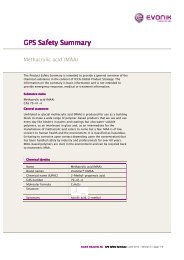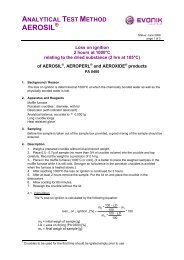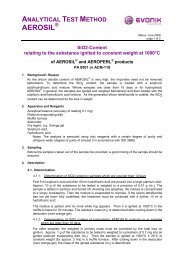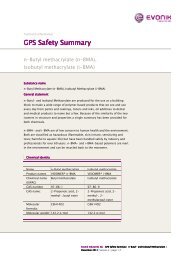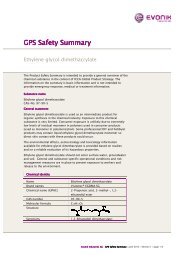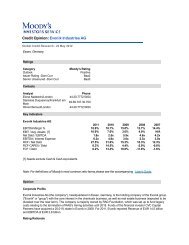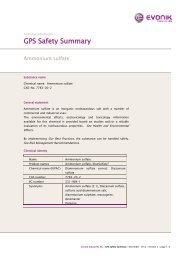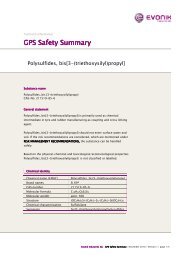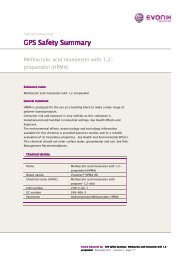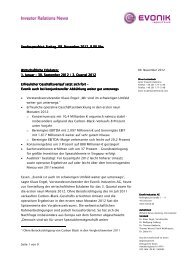Paper Sizing with AERODISP® Fumed Silica Dispersions - Aerosil
Paper Sizing with AERODISP® Fumed Silica Dispersions - Aerosil
Paper Sizing with AERODISP® Fumed Silica Dispersions - Aerosil
Create successful ePaper yourself
Turn your PDF publications into a flip-book with our unique Google optimized e-Paper software.
<strong>Paper</strong> <strong>Sizing</strong> <strong>with</strong> AERODISP ®<br />
<strong>Fumed</strong> <strong>Silica</strong> <strong>Dispersions</strong><br />
Technical Information TI 1322<br />
Invented to improve ®
Table of Contents<br />
1<br />
2<br />
2.1<br />
2.2<br />
2.3<br />
2.4<br />
3<br />
4<br />
4.1<br />
4.2<br />
4.3<br />
4.4<br />
4.4.1<br />
4.4.2<br />
4.4.3<br />
4.4.4<br />
4.5<br />
4.6<br />
4.7<br />
4.7.1<br />
4.7.2<br />
4.8<br />
5<br />
6<br />
6.1<br />
6.2<br />
6.3<br />
7<br />
8<br />
Overview<br />
Manufacture and Properties of AEROSIL ® and AERODISP ®<br />
Manufacturing Process<br />
High Purity<br />
Fine Structure<br />
<strong>Dispersions</strong><br />
<strong>Paper</strong> <strong>Sizing</strong> <strong>with</strong> AERODISP ® : Mode of Action<br />
Experimental Part: <strong>Paper</strong> <strong>Sizing</strong> <strong>with</strong> AERODISP ® <strong>Fumed</strong> <strong>Silica</strong> <strong>Dispersions</strong><br />
<strong>Paper</strong> <strong>Sizing</strong> Trials <strong>with</strong> PVA Based Formulations<br />
<strong>Paper</strong> <strong>Sizing</strong> Trials <strong>with</strong> Starch Based Formulations<br />
Image Quality Measurements<br />
Results <strong>with</strong> PVA Based <strong>Sizing</strong> Formulations<br />
Color Quality<br />
Print Uniformity<br />
Print Resolution<br />
Overview Print Performance<br />
Results <strong>with</strong> Starch Based <strong>Sizing</strong> Formulations<br />
Comparison to Colloidal <strong>Silica</strong> and Calcium Carbonate<br />
The Performance of AERODISP ® Sized <strong>Paper</strong>s in Other Printing Technologies<br />
Xerography<br />
Flexography<br />
Guide Formulations<br />
Processing Advantages <strong>with</strong> AERODISP ®<br />
Packaging, Delivery and Storage<br />
Handling<br />
Material Safety Data Sheets<br />
Additional Information<br />
Product Overview<br />
References<br />
Page<br />
4<br />
5<br />
5<br />
5<br />
5<br />
6<br />
7<br />
7<br />
8<br />
8<br />
8<br />
10<br />
10<br />
10<br />
10<br />
11<br />
11<br />
12<br />
14<br />
14<br />
14<br />
15<br />
16<br />
17<br />
17<br />
17<br />
17<br />
18<br />
19<br />
3
4<br />
1 Overview<br />
Following the DRUPA 2008 exhibition it is clear that<br />
commercial inkjet printing will compete fiercely <strong>with</strong><br />
traditional printing processes in the forthcoming years.<br />
While special paper is already available for offset printing<br />
and other impact printing processes, papers that meet the<br />
requirements of high speed inkjet printers are just in the<br />
infancy of their development. Standard office papers still<br />
exhibit significant weaknesses in such important properties<br />
as optical density, color gamut, and water resistance.<br />
The commonly available Bright White type “inkjet paper”<br />
is perceived to be superior to common “office paper” for<br />
inkjet printing. The most outstanding feature is, as the<br />
name implies, high brightness values, which deliver high<br />
contrast between the printed image and sheet. In reality,<br />
there is minimal distinction in their performance on an<br />
inkjet printer, relative to the less expensive “office papers”.<br />
At first glance, it may seem scant attention was given to<br />
improving the quality of the inkjet image. The reason<br />
might well be the lack of a viable technical alternative to<br />
the polymeric surface treatments which currently dominate<br />
at the size press of the paper machine.<br />
At the high end of the inkjet media market, glossy photorealistic<br />
inkjet papers are using AEROSIL ® fumed silica and<br />
AEROXIDE ® fumed alumina based microporous paper<br />
coatings to realize performance benefits in terms of instant<br />
dry times, water-fastness as well as excellent color gamut<br />
and image resolution. This approach, which emphasizes<br />
the benefits of a micro-particle network, can also be used<br />
for everyday paper products such as office and printing<br />
papers to truly enhance their imaging performance.<br />
<strong>Paper</strong> sizing <strong>with</strong> AERODISP ® fumed silica dispersions<br />
impart a consistent pore structure on the paper surface<br />
allowing ink to be absorbed uniformly and efficiently<br />
(Figure 1). AERODISP ® fumed silica dispersions, when<br />
combined <strong>with</strong> commonly used sizing agents such as<br />
starch or polyvinyl alcohol, will enhance:<br />
• Color gamut and optical density<br />
• Print uniformity (mottle & grain)<br />
• Print resolution (line width, raggedness & blurriness)<br />
• Reduction of print-through (strike through)<br />
The thin fumed silica coating behaves like an inorganic<br />
sponge <strong>with</strong> a well defined void and capillary structure<br />
to absorb ink.<br />
Figure 1 Inkjet prints after surface sizing of plain paper <strong>with</strong><br />
cationic starch (left) compared to a combination of<br />
AERODISP ® WK 7330 and cationic starch at a ratio of<br />
2:1 (right)<br />
AERODISP ® fumed silica dispersions are extremely efficient<br />
- coat weights of as low as 0.5 – 1.0 g/m 2 (corresponding<br />
to 5.5 – 11.0 kg/metric ton paper) are sufficient<br />
to achieve these performance characteristics. They are<br />
compatible <strong>with</strong> most sizing formulations and equipment.<br />
The addition of AERODISP ® to many polymer based<br />
formulations – starch and polyvinyl alcohol included – is<br />
also accompanied by a reduction in viscosity. For a given<br />
viscosity requirement, higher application solids can be<br />
achieved at the size press. The combination of high solids<br />
(less water to be evaporated) and a porous structure<br />
(more efficient evaporation) may reduce the energy<br />
required during the drying process.<br />
<strong>Sizing</strong> formulations based on AERODISP ® fumed silica<br />
dispersions can be applied <strong>with</strong> all common size press<br />
types, such as a puddle or metering type size press, a gate<br />
roll or calendar box.
<strong>Paper</strong>-sizing <strong>with</strong> AERODISP ® does not only improve the<br />
inkjet print performance but enables the manufacture<br />
of multifunctional papers which can be used on various<br />
printing platforms such as flexography. Although other<br />
non-impact printing processes such as laser printing do<br />
not benefit from the thin microporous layer, the papers<br />
nevertheless remain compatible and can be printed <strong>with</strong>out<br />
any loss in quality.<br />
AERODISP ® fumed silica dispersions are a family of water<br />
based dispersions of fumed silicon dioxide. One of the<br />
most distinct characteristics that set AERODISP ® dispersions<br />
apart from common colloidal systems, for example<br />
colloidal silica sols, is the “aggregate structure” and the<br />
high purity of the fumed silica particles. The following<br />
products are especially efficient for paper sizing:<br />
• AERODISP ® WK 7330, a cationic water-based dispersion<br />
that contains 30 % by weight of fumed silica. It improves<br />
print performance and water-fastness, combined<br />
<strong>with</strong> cost-efficiency and high formulation flexibility. It is<br />
the product of choice for most paper products.<br />
• AERODISP ® W 7330 N, a water-based alkaline<br />
dispersion <strong>with</strong> 30 % by weight of fumed silica, is well<br />
suited for acid free sheets where formulation flexibility<br />
and cost efficiency are key and water-fastness is less<br />
important.<br />
Evonik Industries filed several patents pertaining to fumed<br />
silica dispersions and their use in the paper industry.<br />
Information on further AERODISP ® fumed silica and fumed<br />
metal oxide dispersions are given in the corresponding<br />
literature summarized in Chapter 8.<br />
2 Manufacture and Properties of<br />
AEROSIL ® and AERODISP ®<br />
2.1 Manufacturing Process<br />
AERODISP ® fumed silica dispersions are produced by dispersing<br />
AEROSIL ® fumed silica powder in the appropriate<br />
solvent. AEROSIL ® fumed silica in turn is manufactured by<br />
the hydrolysis of volatile silicon compounds, for example<br />
silicon tetrachloride, in a hydrogen/oxygen flame according<br />
to the following chemical reaction:<br />
SiCl 4 + 2H 2 + O 2 � SiO 2 + 4 HCl<br />
Since it is produced by flame hydrolysis, AEROSIL ® is considered<br />
a fumed silicon dioxide or fumed silica. Because of<br />
its fine particle structure, the product is also referred to as<br />
highly dispersed silicon dioxide. Other metal oxides, such<br />
as aluminum oxide, and titanium dioxide, can also be produced<br />
using the AEROSIL ® process. They are marketed<br />
under the trade name AEROXIDE ® .<br />
2.2 High Purity<br />
AEROSIL ® fumed silica has a silicon dioxide content of<br />
more than 99.8 % by weight and is pure amorphous silica.<br />
The heavy metal content is below the detection limit of<br />
most current analytical methods.<br />
2.3 Fine Structure<br />
During the manufacture of AEROSIL ® fumed silica, the<br />
vaporized silicon precursor reacts <strong>with</strong> water (formed by<br />
hydrogen and oxygen gas) to form the individual particles<br />
of silicon dioxide (Figure 2). However, these particles do<br />
not remain isolated, but collide; bond and sinter together,<br />
resulting in branched chain aggregates <strong>with</strong> a length of<br />
approx. 100 to 200 nanometers. The aggregates are the<br />
Figure 2 Schematic representation of AEROSIL ® fumed silica<br />
primary particles, aggregates, and agglomerates.<br />
Aggregates<br />
(appr. 100 - 300 nm)<br />
Primary particles<br />
(70 - 40 nm) Agglomerates<br />
(up to > 100 microns)<br />
5
6<br />
smallest actual units of fumed silica. Once the aggregates<br />
cool down below the fusion point, additional collisions<br />
result in mechanical entanglement and hydrogen bonding<br />
of the chains, called agglomeration. The size of the<br />
agglomerates may be several hundred microns. Because<br />
agglomerates are only bound through weak forces, they<br />
can easily be broken down to aggregates during dispersion.<br />
2.4 <strong>Dispersions</strong><br />
Evonik’s comprehensive and innovative dispersion knowhow<br />
is the key to the commercial production of AEROSIL ®<br />
fumed silica dispersions. Offered under the trademark<br />
AERODISP ® , they are characterized by high fumed silica<br />
contents and narrow particle size distributions between<br />
100 and 200 nm (Figure 3).<br />
Figure 3 Particle size distribution of the fumed silica dispersion<br />
AERODISP ® WK 7330<br />
q3 (%) Q3 (%)<br />
35<br />
30<br />
25<br />
20<br />
15<br />
10<br />
5<br />
0<br />
20<br />
10<br />
0.01 0.10 1.00<br />
size ( µ m)<br />
10.00 100.00 1000.00<br />
One of the most distinctive features of AERODISP ® fumed<br />
silica dispersions is their “aggregate structure” (Figure 4),<br />
whereas common colloidal systems, for example colloidal<br />
silica sol, consist of isolated (non-aggregated) primary particles.<br />
The “aggregate structure” yields excellent results in<br />
paper products, even when very small quantities are used.<br />
Figure 4 Computer model of an AEROSIL ® fumed silica aggregate<br />
100<br />
90<br />
80<br />
70<br />
60<br />
50<br />
40<br />
30<br />
Due to their negative zeta potential throughout most<br />
of the pH range, fumed silica dispersions are especially<br />
stable in alkaline pH ranges. An example for an alkaline<br />
fumed silica dispersion is the previously described product<br />
AERODISP ® W 7330 N.<br />
Cationized fumed silica dispersions, such as AERODISP ®<br />
WK 7330 are ideal to use in paper products. Their zeta<br />
potential curve is modified through the addition of a<br />
cationic polymer and resembles that of fumed aluminum<br />
oxide dispersions (Figure 5).<br />
Figure 5 Schematic representation of a silica particle interacting<br />
<strong>with</strong> a cationic polymer<br />
The choice of special polymer types and suitable dispersing<br />
techniques prevents flocculation and, at the same time,<br />
stabilizes the system at an acidic pH. The cationic surface<br />
charge enables the production of paper coatings <strong>with</strong><br />
strong dye / pigment bonding, resulting in brilliant colors<br />
and high water-resistance.<br />
High solids contents in combination <strong>with</strong> low viscosities<br />
make AERODISP ® fumed silica dispersions especially easy<br />
to handle and work <strong>with</strong>.
3 <strong>Paper</strong> <strong>Sizing</strong> <strong>with</strong> AERODISP ® :<br />
Mode of Action<br />
<strong>Paper</strong> is a low surface area material which has an irregular<br />
structure of large voids / pores. This aspect allows the<br />
liquid ink to travel randomly into the structure and along<br />
the fibers resulting in prints that have a ragged and<br />
blurred quality. <strong>Sizing</strong> <strong>with</strong> AERODISP ® imparts a consistent<br />
high surface area pore structure at the paper surface<br />
to enable inks to be absorbed uniformly and efficiently.<br />
This leads to printed images <strong>with</strong> high gamut values, uniform<br />
ink absorption and low raggedness and blurriness.<br />
The fractal structure of the fumed silica aggregate is the<br />
basis of the microporous matrix <strong>with</strong>in coating / sizing<br />
layer. Its sponge-like structure <strong>with</strong> well defined pores and<br />
channels provides the capillary action needed to quickly<br />
transport the ink vehicle away from the paper surface and<br />
to prevent spreading along the fibers. Liquid absorption<br />
via capillary action in a microporous system is much faster<br />
than in purely polymeric systems that rely upon diffusion<br />
and solvation. The resulting penetration properties allow<br />
the use of high speed printers while maintaining optimum<br />
image quality. The dyes and/or pigments are absorbed on<br />
the surface of the solid particles <strong>with</strong> pin-point accuracy<br />
resulting in brilliant colors, excellent print uniformity and<br />
high resolution.<br />
Figure 6 Schematic drawing of an AERODISP ® size press<br />
treated paper<br />
AEROSIL ® aggregates<br />
create an inorganic sponge<br />
that rapidly absorbs and<br />
immobilizes ink<br />
Ink drop<br />
Pores and capillares<br />
absorb the ink drops<br />
Base paper<br />
4 Experimental Part: <strong>Paper</strong> <strong>Sizing</strong> <strong>with</strong><br />
AERODISP ® <strong>Fumed</strong> <strong>Silica</strong> <strong>Dispersions</strong><br />
AERODISP ® fumed silica dispersions impart a consistent<br />
pore structure on the paper surface enabling uniform and<br />
efficient ink absorption. AERODISP ® dispersions can be<br />
combined <strong>with</strong> commonly used binders such as polyvinyl<br />
alcohol or starch, are compatible <strong>with</strong> most sizing formulations<br />
and equipment and can reduce drying energy required.<br />
<strong>Sizing</strong> formulations containing AERODISP ® fumed<br />
silica dispersions can be applied <strong>with</strong> a puddle or metering<br />
type size press, a gate roll or calendar box.<br />
This technical information discusses laboratory experiments<br />
using wire wound rods and an extensive online-sizing trial<br />
<strong>with</strong> a puddle-type size press at a small Kämmerer paper<br />
machine to apply the functional treatments. While differences<br />
were noticeable between laboratory and machine<br />
trials, in all cases we observed significant improvements of<br />
the print quality in comparison to the corresponding<br />
papers <strong>with</strong> pigment-free sizing solutions.<br />
Figure 7 Laboratory procedure for the preparation of coated<br />
paper samples (dye added for better visibility of the<br />
coating)<br />
Figure 8 Kämmerer paper machine “XPM” used for onlinesizing<br />
trials. The small picture shows the puddle-type<br />
size press.<br />
7
8<br />
The puddle size press is a common piece of equipment<br />
on many paper machines used to apply a functional treatment.<br />
The size press solution typically has a low solids<br />
content and viscosity. Detailed operations of the size press<br />
is beyond the scope of this paper, but in general, the press<br />
forces the size press solution into the voids between fibers<br />
via hydraulic pressure and leads to the sheet being saturated<br />
as opposed to the surface treatment obtained <strong>with</strong><br />
metering size presses or coaters.<br />
4.1 <strong>Paper</strong> <strong>Sizing</strong> Trials <strong>with</strong> PVA Based<br />
Formulations<br />
To simulate the size press treatment in the lab environment,<br />
the coating formulation containing AERODISP ®<br />
was formulated to 4 % solids resulting in a Brookfield<br />
viscosity of less than 100 cPs. The coating was comprised<br />
of 100 dry parts of a cationized AEROSIL ® fumed silica<br />
(AERODISP ® WK 7330, Evonik), 10 dry parts of polyvinyl<br />
alcohol (CELvOL ® 523, Celanese) and 15 dry parts<br />
of a cationic polymer (Induquat ECR 35L, Indulor Chemie<br />
GmbH). This coating was applied to a multi-purpose printing<br />
paper (20 lb Spectrum ® DP, Georgia Pacific) <strong>with</strong> the<br />
appropriate wire-wound rod (see Figure 7), dried <strong>with</strong> a<br />
heated forced air gun and then dried under restraint using<br />
a Laboratory Sheet Dryer (Model S 100, Adirondack<br />
Machine Corporation). This approach allowed the treatment<br />
to saturate the sheet, minimize wrinkles and avoid<br />
curl, while obtaining low pickup weights. The correlation<br />
between rod size and coat weight was linear as seen in<br />
Figure 9.<br />
Figure 9 Correlation between rod number and coat weight<br />
Coat Weight (g/m )<br />
2<br />
2.0<br />
1.5<br />
1.0<br />
0.5<br />
0<br />
0 10 5<br />
20 10 30<br />
15<br />
Rod Wire Size (mils)/( µ<br />
m)<br />
In this technical information the results given for PvA containing<br />
formulations are mainly based on off-line laboratory<br />
trials. For the online-sizing trials the solids content of<br />
the different PvA based formulations was kept constantly<br />
at 11 %.<br />
4.2 <strong>Paper</strong> <strong>Sizing</strong> Trials <strong>with</strong> Starch Based<br />
Formulations<br />
For both laboratory and online pilot plant trials the sizing<br />
solutions used were at 11 % solids. Either cationic starch or<br />
non-ionic starch were dissolved in a jet cooker and held at<br />
a constant temperature of 60 °C before use.<br />
For the lab trials unsized inkjet base paper was used as<br />
substrate; the sizing formulation was applied using a wirewound<br />
rod (Figure 7) <strong>with</strong> resulting coat weights of<br />
1.0 g/m 2 . For the online-sizing trials (Kämmerer machine<br />
at MoRe, Sweden, Figure 8) a standard chemical pulp<br />
consisting of birch and pine fibers was used (Hi-Cat starch,<br />
PCC filler, ASA sizing, Percol and Bentonite as micro-<br />
particle retention aid, <strong>with</strong>out optical brighteners). Fibers<br />
were beaten to a usual value of 25 °SR (Schopper-Riegler).<br />
Pulp stock conductivity and pH were adjusted to the same<br />
level for each of the trials.<br />
The paper machine was run at constant speed (1.8 m/min)<br />
and drying conditions during all trials. The only variable<br />
was the composition of the sizing solution. The coat weight<br />
on the top side of the paper was about 0.5 – 0.7 g/m 2 .<br />
4.3 Image Quality Measurements<br />
The treated papers were printed on various inkjet printers,<br />
such as Hewlett-Packard Photosmart 8250, Hewlett-<br />
Packard Deskjet 5652, Epson Stylus PHOTO R 200, Epson<br />
Stylus PHOTO R 240, and Canon PIXMA iP 6600 D.<br />
These printers were selected for their distinctly different<br />
ink sets and printing mechanisms employed. The Epson<br />
inks typically contain higher concentrations of organic solvents<br />
which make them more discriminating <strong>with</strong> respect<br />
to the paper used. Results on additional printers such as<br />
Epson Stylus PHOTO R 2400, Epson Stylus PHOTO R 285,<br />
Epson Stylus PHOTO R 800, HP Photosmart D 7360 and<br />
Kodak Easyshare 5300 are available on request.
Print patterns were created <strong>with</strong> CorelDRAW ® software<br />
(Figures 10a and 10b). They contain the various elements<br />
needed for quantifying print attributes such as optical density,<br />
color gamut area, print mottle and grain, inter-color<br />
bleeding and dot circularity.<br />
All data in this study were obtained <strong>with</strong> both the<br />
“Personal Image Analysis System” (PIAS) (QEA Inc.)<br />
and the SpectroEye ® Densitometer (GretagMacbeth<br />
Switzerland ).<br />
Figure 10a Print pattern A for the evaluation of the print<br />
performance<br />
AERODISP ® WK 7330<br />
HP-Photosmart 8250<br />
Bright White/Best Quality<br />
= Auto, Ink volume=Auto<br />
Color density and L*a*b* values were measured using<br />
both the SpectroEye and the PIAS device. The gamut area<br />
is calculated based on CIELAB a* and b* values for the<br />
different colored measuring areas.<br />
For calculating the strike through the reflection at 460 nm<br />
of the backside (BS) of the printed area (black) and the unprinted<br />
paper is measured using the SpectroEye<br />
calculation for strike through: log(R B(Sunprinted) / RB(Sprinted) )<br />
values for graininess, mottling and resolution given in<br />
this technical information were determined by PIAS. Line<br />
width, blurriness and raggedness were measured on several<br />
lines of the print patterns A and/or B and the mean<br />
values were calculated.<br />
Figure 10b Print pattern B for the evaluation of print<br />
performance, water fastness and surface strength<br />
In order to graphically illustrate the changes in print performance<br />
versus the corresponding paper sized <strong>with</strong><br />
100 % polymer, the values measured for resolution, color<br />
density, gamut, mottling & graininess and strike through<br />
were converted into relative grades <strong>with</strong> the pigment-free<br />
reference at 1.0. Grades above 1.0 indicate a performance<br />
exceeding the performance of the reference. Differences<br />
of more than 0.05 are significant. It should be pointed out<br />
here that the values for each reference paper itself are always<br />
dependent on the printer used.<br />
9
10<br />
4.4 Results <strong>with</strong> PVA Based <strong>Sizing</strong><br />
Formulations<br />
4.4.1 Color Quality<br />
Optical densities were averaged for the primary colors,<br />
Cyan (C), Magenta (M), Yellow (Y) and Black (K) and<br />
plotted against coat weight for the two inkjet printers.<br />
As depicted in Figure 11, the density values increase in a<br />
linear relationship to coat weight.<br />
Figure 11 Effect of coat weight on optical density<br />
Optical Density<br />
1.5<br />
1.4<br />
1.3<br />
1.2<br />
1.1<br />
1.0<br />
0.9<br />
Coat Weight (g/m )<br />
2<br />
0 0.5 1.0 1.5 2.0<br />
HP 8250 Epson R 200<br />
The color gamut area was calculated from the CIELAB a*<br />
and b* values for the colors cyan, magenta, yellow, red,<br />
green and blue. Higher values indicate the possibility of<br />
making more color combinations and printing those more<br />
accurately. In Figure 12, the color gamut area expands <strong>with</strong><br />
increasing coat weights.<br />
The increased performance in these color qualities is<br />
achieved when the ink resides at or near the surface of the<br />
sheet or if the coating is transparent. The unique structure<br />
Figure 12 Effect of coat weight on color gamut area<br />
Color Gamut Area<br />
7200<br />
6700<br />
6200<br />
5700<br />
5200<br />
Coat Weight (g/m )<br />
2<br />
0.0 0.2 0.4 0.6 0.8 1.0 1.2 1.4 1.6 1.8 2.0<br />
HP 8250 Epson R 200<br />
of the fumed silica aids in immobilizing the colorant near<br />
the surface. Its small aggregate size helps to maintain<br />
transparency enabling vivid colors and bold images.<br />
4.4.2 Print Uniformity<br />
When ink is absorbed too slowly or unevenly by the coating,<br />
the image may appear “spotty” or mottled. In spite of<br />
high color values (e. g.; optical density, gamut) that might<br />
be obtained, the resulting print would be unacceptable.<br />
Mottle is a measure of coarse scale color density nonuniformity<br />
(> 250 µm), while grain is a measure of this nonuniformity<br />
at a finer scale (< 250 µm). In Figure 13, print<br />
mottle and print grain are simultaneously reduced as<br />
treatment levels increase. In both cases the use of a fumed<br />
silica treatment improves the quality of the image.<br />
Figure 13 Effect of coat weight on print mottle<br />
Mottle (%R)<br />
1.1<br />
1.0<br />
0.9<br />
0.8<br />
0.7<br />
0.6<br />
0.5<br />
Coat Weight (g/m )<br />
2<br />
0 0.5 1.0 1.5 2.0<br />
HP 8250 Epson R 200<br />
4.4.3 Print Resolution<br />
In inkjet printing, the dot is the most fundamental element<br />
and is the basis for constructing higher level elements such<br />
as lines, text characters, graphics and images. The quality<br />
of the dot formed is a critical indicator of a print’s final<br />
quality. The circularity of the dot is influenced by uniform<br />
ink absorption. For this element, dots <strong>with</strong> a nominal size<br />
of 100 µm were printed and evaluated for their circularity.<br />
In this metric, a value of 1.0 (aspect ratio) represents a perfectly<br />
round dot. As shown in Figure 14, the dot circularity<br />
improves as the fumed silica treatment level increases.
Figure 14 Effect of coat weight on dot circularity at 100 µm<br />
Dot Circularity ( µ m)<br />
2.5<br />
2.4<br />
2.3<br />
2.2<br />
2.1<br />
2.0<br />
1.9<br />
Coat Weight (g/m )<br />
2<br />
0 0.5 1.0 1.5 2.0<br />
HP 8250 Epson R 200<br />
Line quality is another important consideration for evaluating<br />
print quality, as it correlates strongly to text quality.<br />
The amount of line growth, particularly when the line can<br />
“bleed” into another adjacent color, reveals the ink-media<br />
interactions.<br />
The deviation from a nominal line thickness of 280 µm is<br />
averaged for 12 combinations of primary line colors (K, C,<br />
M and Y) on blocks of the four primary colors. Figure 15<br />
shows how increased coat weights reduce line bleed.<br />
Figure 15 Effect of coat weight on line bleed<br />
Line Bleed ( µ m)<br />
100<br />
90<br />
80<br />
70<br />
60<br />
50<br />
Coat Weight (g/m )<br />
2<br />
0 0.5 1.0 1.5 2.0<br />
HP 8250 Epson R 200<br />
4.4.4 Overview Print Performance<br />
The results obtained from the online-sizing trials were<br />
consistent <strong>with</strong> the laboratory results and particularly<br />
demonstrated that the addition of fumed silica to a PvA<br />
based sizing formulation has a very positive effect on print<br />
uniformity (Figure 16).<br />
Figure 16 Print performance of PvA sized papers <strong>with</strong> and<br />
<strong>with</strong>out fumed silica (AERODISP ® WK 7330 at a<br />
pigment to binder ratio of 2 : 1. Mean values of three<br />
different printers.)<br />
relative grades<br />
5.0<br />
4.5<br />
4.0<br />
3.5<br />
3.0<br />
2.5<br />
2.0<br />
1.5<br />
1.0<br />
0.5<br />
0.0<br />
PVA<br />
cationized<br />
®<br />
AERODISP WK 7330<br />
+ PVA cationized<br />
PVA<br />
cationized+<br />
crosslinked<br />
Gamut Colour Density Print Through Ink Uniformity<br />
®<br />
AERODISP WK 7330<br />
+ PVA cat./crossl.<br />
4.5 Results <strong>with</strong> Starch Based <strong>Sizing</strong><br />
Formulations<br />
better<br />
Also the addition of AERODISP ® to comparatively inexpensive<br />
starch based formulations leads to a significant improvement<br />
in print performance even at pigment to binder<br />
ratios between 2:1 and 1:1 (Figure 17).<br />
Figure 17 Print performance of cationic starch sized papers <strong>with</strong><br />
and <strong>with</strong>out fumed silica (AERODISP ® WK 7330 at a<br />
pigment to binder ratio of 1 : 1 and 2 : 1, respectively.<br />
Mean values of three different printers.)<br />
relative grades<br />
5.0<br />
4.0<br />
3.0<br />
2.0<br />
1.0<br />
0.0<br />
Gamut<br />
1.00<br />
1.00<br />
1.00<br />
Cationic<br />
starch<br />
Colour Density<br />
1.00 1.10 1.12<br />
®<br />
AERODISP WK 7330<br />
+ cationic corn starch. 1:1<br />
Print Through<br />
Ink Uniformity<br />
1.57 1.53<br />
1.14 1.12<br />
1.05 1.05<br />
better<br />
®<br />
AERODISP WK 7330<br />
+ cationic corn starch. 2:1<br />
11
12<br />
While print through, color density and color gamut<br />
increased between 5 and 15 %, print uniformity was<br />
enhanced by more than 50 % in comparison to the treatment<br />
<strong>with</strong> pure cationic starch (Figure 18). As for the trials<br />
<strong>with</strong> PvA based formulations discussed in the previous<br />
section, the findings from various offline-sizing experiments<br />
in the laboratory were confirmed by the online-<br />
sizing trials. The data contained in these graphs are based<br />
on prints from the Epson Stylus PHOTO R 240,<br />
HP Deskjet 5652 and Canon PIXMA iP 6600 D. Data<br />
obtained <strong>with</strong> other printers, using dye as well as pigment<br />
based inks, are available on request.<br />
Figure 18 Relative improvement of various print properties<br />
resulting from the addition of AERODISP ® WK 7330<br />
to a cationic corn starch based sizing formulation<br />
Relative Improvements using AERODISP ®<br />
Similar results were found <strong>with</strong> non-ionic starch based<br />
formulations where AERODISP ® had a positive impact<br />
on print performance and in particular ink uniformity<br />
(Figure 19).<br />
Figure 19 Print performance of non-ionic starch sized papers<br />
<strong>with</strong> and <strong>with</strong>out fumed silica (AERODISP ® W 7330 N<br />
at a pigment to binder ratio of 2 : 1. Mean values of<br />
three different printers.)<br />
relative grades<br />
4.0<br />
3.5<br />
3.0<br />
2.5<br />
2.0<br />
1.5<br />
1.0<br />
0.5<br />
0.0<br />
Ink Uniformity<br />
Print Through<br />
Colour Density<br />
4.5 better<br />
Gamut<br />
Gamut<br />
Print Through<br />
+12 %<br />
+10 %<br />
+14 %<br />
+5 %<br />
+5 %<br />
+12 %<br />
WK 7330 + cationic corn starch 2:1<br />
WK 7330 + cationic corn starch 1:1<br />
1.00<br />
1.00<br />
1.00<br />
1.00<br />
Non-ionic<br />
starch<br />
Colour Density<br />
Ink Uniformity<br />
1.19<br />
1.07<br />
1.02<br />
1.06<br />
+53 %<br />
+57 %<br />
+0 % +10 % +20 % +30 % +40 % +50 % +60 %<br />
®<br />
AERODISP WK 7330 N<br />
+ non-ionic starch 2:1<br />
Along <strong>with</strong> evaluating the print performance of relatively<br />
“slow” office printers, we also looked at the penetration<br />
speed of water based liquids into the paper surface using<br />
dynamic liquid penetration.<br />
As seen in Figure 20, fumed silica coated papers have a<br />
distinctly faster penetration behavior compared to a reference<br />
paper surface treated <strong>with</strong> pure starch. The capillary<br />
forces of the approx. 20 to 100 nm wide pores are an<br />
important feature of the fumed silica-based coating that<br />
can play a major role in addressing the needs of high speed<br />
commercial inkjet printers.<br />
Figure 20 Dynamic liquid penetration into starch sized papers<br />
<strong>with</strong> and <strong>with</strong>out AERODISP ® WK 7330 (measured<br />
using an emco DPM-33, emco, Leipzig, Germany)<br />
Transmission [dB]<br />
-18<br />
-19<br />
-20<br />
-21<br />
-22<br />
-23<br />
-24<br />
Fast wetting and quick capillary penetration<br />
0.1 1 10<br />
Time [sec]<br />
<strong>Paper</strong> sized <strong>with</strong> cationic corn starch<br />
<strong>Paper</strong> sized <strong>with</strong> WK 7330 + cationic corn starch (2:1)<br />
4.6 Comparison to Colloidal <strong>Silica</strong> and<br />
Calcium Carbonate<br />
Calcium carbonate and colloidal silica are both well known<br />
pigments in the paper industry and could be considered<br />
for paper sizing as well. We therefore compared one well<br />
established CaCO 3 grade used for paper coatings and two<br />
different types of colloidal silica <strong>with</strong> our AERODISP ®<br />
fumed silica dispersions in typical paper sizing formulations.<br />
As shown in Figure 21, the addition of colloidal silica to a<br />
non-ionic starch based sizing formulation did not result in<br />
any significant improvement of print performance versus<br />
the pure starch formulation. On the other hand, AERODISP ®<br />
substantially enhanced color density, color gamut and in<br />
particular ink uniformity. Colloidal silica consists exclusively<br />
of discrete, isolated spherical particles and lacks a<br />
fractal or secondary structure. In contrast to fumed silica,<br />
it therefore provides only very limited additional porosity<br />
and adsorptivity.
Figure 21 Print performance of non-ionic starch sized paper<br />
<strong>with</strong> AERODISP ® W 7330 N compared to colloidal<br />
silica (Pigment to binder ratio 2 : 1. Mean values of<br />
three printers.)<br />
relative grades<br />
3.5<br />
3.0<br />
2.5<br />
2.0<br />
1.5<br />
1.0<br />
0.5<br />
0.0<br />
Gamut<br />
1.00<br />
1.00<br />
1.00<br />
Non-ionic<br />
starch<br />
Ink Uniformity<br />
1.19<br />
1.02<br />
1.06<br />
®<br />
AERODISP W 7330 N<br />
+ non-ionic starch 2:1<br />
Colour Density<br />
Colloidal silica type A<br />
+ non-ionic starch, 2:1<br />
better<br />
Colloidal silica type B<br />
+ non-ionic starch, 2:1<br />
Different from colloidal silica, calcium carbonate can have<br />
a positive impact on print performance; however it is clearly<br />
inferior to AERODISP ® in cationic sizing formulations<br />
(Figure 22).<br />
1.06<br />
0.99<br />
0.99<br />
1.00<br />
1.01<br />
1.01<br />
Figure 22 Print performance of cationic starch sized papers <strong>with</strong><br />
AERODISP ® WK 7330 compared to calcium<br />
carbonate (Pigment to binder ratio 2 : 1. Mean<br />
values of three printers.)<br />
relative grades<br />
Figure 23 Scanning Electron Microscopic (SEM) images (two different magnifications) of paper surfaces sized <strong>with</strong> pure cationic corn<br />
starch (left), cationic corn starch combined <strong>with</strong> AERODISP ® WK 7330 (middle), calcium carbonate (right), respectively.<br />
<strong>Paper</strong> sized <strong>with</strong><br />
cationic corn starch<br />
4.0<br />
3.0<br />
2.0<br />
1.0<br />
0.0<br />
Gamut<br />
1.00<br />
1.00<br />
Cationic<br />
starch<br />
Colour Density<br />
1.00 1.16 1.02<br />
®<br />
AERODISP WK 7330<br />
+ cationic corn starch. 2:1<br />
Ink Uniformity<br />
2.01<br />
1.04<br />
1.89<br />
0.92<br />
better<br />
Calcium carbonate slurry type I<br />
+ cationic corn starch, 2:1 +<br />
viewing the surface of paper sized <strong>with</strong> combinations of<br />
fumed silica and starch versus pure polymer and/or calcium<br />
carbonate under an electron microscope (Figure 23)<br />
provides an idea of the critical factors that account for<br />
the superior printing results obtained <strong>with</strong> AERODISP ®<br />
products.<br />
®<br />
<strong>Paper</strong> sized <strong>with</strong> AERODISP WK 7330 <strong>Paper</strong> sized <strong>with</strong> calcium carbonate<br />
+ cationic corn starch<br />
+ cationic corn starch<br />
13
14<br />
Nano-structured fumed silica creates a very thin yet<br />
smooth and porous coating that covers the paper fibers<br />
more or less completely. Dyes or color pigments are retained<br />
at the surface of the silica particles resulting in higher<br />
optical densities and an expanded color gamut area. As<br />
seen in the SEM micrographs, the paper surface is visibly<br />
more homogeneous, which in turn has a favorable effect<br />
on print resolution and ink uniformity.<br />
In contrast, the much larger, micron sized calcium carbonate<br />
particles only provide some additional porosity for ink<br />
absorption; however, the surface coverage is inhomo-<br />
geneous.<br />
The particle size distribution curve of fumed silica in<br />
Figure 24 in comparison to calcium carbonate makes it<br />
apparent why the paper sizing <strong>with</strong> an AERODISP ® containing<br />
formulation give a smooth sponge-like surface.<br />
Figure 24 Particle size distributions (volume) of two different<br />
AERODISP ® fumed silica dispersions in comparison<br />
to calcium carbonate (Horiba LA-910)<br />
q3 (%) Q3 (%)<br />
35<br />
30<br />
25<br />
20<br />
15<br />
10<br />
5<br />
0<br />
20<br />
10<br />
0.01 0.10 1.00<br />
size ( µ m)<br />
10.00 100.00 1000.00<br />
®<br />
AERODISP WK 7330<br />
®<br />
AERODISP W 7330 N<br />
Calcium carbonate<br />
4.7 The Performance of AERODISP ® Sized<br />
<strong>Paper</strong>s in Other Printing Technologies<br />
The outstanding performance of AERODISP ® sized press<br />
treated papers in inkjet printing has been proven for many<br />
sizing formulations and conditions as well as on numerous<br />
printers. But what about other printing technologies?<br />
4.7.1 Xerography<br />
AERODISP ® sized papers, produced during our onlinesizing<br />
trial, were printed on two different laser printing<br />
devices: a XEROX DC 12 using a conventional toner and a<br />
XEROX DC 3535 operating <strong>with</strong> a modern chemical toner.<br />
With both devices the papers could be printed <strong>with</strong>out any<br />
100<br />
90<br />
80<br />
70<br />
60<br />
50<br />
40<br />
30<br />
major problems. Although significant improvements were<br />
not observed, there was no degradation in print performance<br />
and quality relative to the reference.<br />
4.7.2 Flexography<br />
Optical density and print uniformity are also important<br />
attributes on conventional printing platforms such as flexography.<br />
The online-sizing pilot trial samples were printed<br />
<strong>with</strong> black, water based flexographic ink using the<br />
FlexiProof 100 (RK Print Coat Instruments). In this preliminary<br />
evaluation, optical density and print uniformity were<br />
both improved by the addition of fumed silica to the sizing<br />
agents (PvA and starch).<br />
Figure 25 Black optical density increases <strong>with</strong> the addition of<br />
AERODISP ® fumed silica to the size press treatment<br />
Black Print Density<br />
1.30<br />
1.25<br />
1.20<br />
Binder only WK 7330<br />
1.26<br />
Surface Treatment<br />
Untreated<br />
Figure 26 Print uniformity, on a fine scale improves when<br />
AERODISP ® is added to the sizing agent(s), as seen<br />
by the reduction in print grain<br />
Print Grain (%)<br />
1.25<br />
1.15<br />
1.05<br />
0.95<br />
0.85<br />
0.75<br />
Binder only WK 7330<br />
1.05<br />
Surface Treatment<br />
Untreated
Figure 27 Print uniformity, on a coarse scale, also improves<br />
when AERODISP ® is added to the sizing agent(s),<br />
as seen by the reduction in print mottle.<br />
Print Mottle (%)<br />
0.65<br />
0.60<br />
0.55<br />
0.50<br />
0.45<br />
0.40<br />
Binder only WK 7330<br />
Table 1 <strong>Sizing</strong> formulation containing cationic corn starch for<br />
printing paper <strong>with</strong> enhanced print performance<br />
Starting Materials Content<br />
(dry parts)<br />
AERODISP ® WK 7330<br />
(Evonik Industries)<br />
C�Film starches<br />
(Cargill)<br />
0.53<br />
Surface Treatment<br />
Untreated<br />
The results described in 4.7.1 and 4.7.2 demonstrate that<br />
paper sizing <strong>with</strong> AERODISP ® not only improves the<br />
inkjet print performance but enables the manufacture<br />
of multi-functional papers which can be used on various<br />
printing platforms.<br />
4.8. Guide Formulations<br />
This section provides guide formulations for paper sizing<br />
<strong>with</strong> AERODISP ® fumed silica dispersions. These formulations<br />
can be adjusted for your specific process and<br />
optimized to meet the desired product properties. Coat<br />
weights between 0.5 and 2.0 g/m 2 are recommended.<br />
The sizing formulation can be applied <strong>with</strong> all common<br />
size press types.<br />
Cationic fumed<br />
silica dispersion<br />
Cationic<br />
corn starch<br />
100<br />
30 – 100<br />
Water Water Adjust to desired<br />
solids content<br />
If a non-ionic starch is preferred, we recommend the<br />
use of our anionic fumed silica dispersion AERODISP ®<br />
W 7330 N.<br />
Table 2 <strong>Sizing</strong> formulation containing polyvinyl alcohol for<br />
high performance printing papers<br />
Starting Materials Content<br />
(dry parts)<br />
AERODISP ® WK 7330<br />
(Evonik Industries)<br />
MOWIOL ® 5 - 88<br />
(Kuraray Europe GmbH)<br />
INDUQUAT ® ECR 35 L<br />
(Indulor Chemie GmbH)<br />
or equivalent<br />
p-DADMAC grades<br />
CARTABOND ® TSI<br />
(Clariant)<br />
DYNOL ® 604<br />
(Air Products)<br />
Cationic fumed silica<br />
dispersion<br />
Polyvinyl alcohol<br />
(partially hydrolyzed,<br />
low molecular weight)<br />
100<br />
10 – 100<br />
Cationic Polymer 5 – 30<br />
Glyoxal resin 0 – 5<br />
Defoamer 0 – 0.5<br />
Water Water Adjust to desired<br />
solids content<br />
Table 3 <strong>Sizing</strong> formulation containing latex for printing paper<br />
<strong>with</strong> enhanced print performance<br />
Starting Materials Content<br />
(dry parts)<br />
AERODISP ® WK 7330<br />
(Evonik Industries)<br />
ACRONAL ® type latex<br />
(BASF AG)<br />
Cationic fumed silica<br />
dispersion<br />
Styrene-acrylate<br />
dispersion<br />
100<br />
25 – 50<br />
LUMITEN ® PPR 8450 PVP 3<br />
ACROSOL ® C 50 L<br />
(BASF AG)<br />
CATIOFAST ® CS<br />
(BASF) or equivalent<br />
p-DADMAC grades<br />
Co-binder/<br />
thickening agent<br />
2.5<br />
Cationic agent 1<br />
Water Water Adjust to desired<br />
solids content<br />
15
16<br />
5 Processing Advantages <strong>with</strong><br />
AERODISP ®<br />
The water evaporation rate in the paper-making process is<br />
an important factor that governs machine speed which in<br />
turn affects the cost of manufacture. Using polymeric film<br />
forming components can inhibit water evaporation<br />
reducing productivity or driving energy costs upward.<br />
The AERODISP ® fumed silica particle creates a void and<br />
channel structure which disrupts film formation enabling<br />
water evaporation to proceed faster.<br />
Figure 28 Water evaporation rate (isothermic TGA scan)<br />
indicating faster water evaporation as a function of<br />
AERODISP ® concentration in the polymeric system<br />
Solids (%)<br />
100<br />
90<br />
80<br />
70<br />
60<br />
50<br />
40<br />
30<br />
20<br />
0 2 4 6 8 10 12 14 16 18 20<br />
Time (min)<br />
100 PVA<br />
10:90<br />
20:80<br />
Figure 29 In this view of the TGA scan, we can see that at a<br />
loading of 10 parts pigment is sufficient to enhance<br />
evaporation while at 40 parts the evaporation rate is<br />
near an optimum<br />
Solids (%)<br />
80<br />
70<br />
60<br />
50<br />
40<br />
30<br />
20<br />
30:70<br />
40:60<br />
50:50<br />
60:40<br />
70:30<br />
80:20<br />
90:10<br />
100 <strong>Fumed</strong> <strong>Silica</strong><br />
5 6 7 8 9<br />
Time (min)<br />
100 PVA<br />
10:90<br />
20:80<br />
30:70<br />
50:50<br />
60:40<br />
100 <strong>Fumed</strong> <strong>Silica</strong><br />
Another important parameter is the solids content of a<br />
paper sizing solution which is limited by the maximum<br />
viscosity processable on a size press. The addition of<br />
AERODISP ® to many polymer based formulations – starch<br />
and polyvinyl alcohol included – is accompanied by a<br />
reduction in viscosity (Figure 30). For a given viscosity<br />
requirement, higher application solids can be achieved at<br />
the size press. The combination of high solids (less water<br />
to be evaporated) and a porous structure (more efficient<br />
evaporation) may reduce the energy required during the<br />
drying process.<br />
Figure 30 viscosity curves of cationic corn starch solutions <strong>with</strong><br />
and <strong>with</strong>out AERODISP ® WK 7330 (measured <strong>with</strong> a<br />
Physica MCR-300 rheometer). The addition of fumed<br />
silica results in a significant reduction of the viscosity<br />
and allows increasing the solids content<br />
mPa . s<br />
100000<br />
10000<br />
1000<br />
100<br />
10<br />
1<br />
0.10 1.00 10.00 100.00 1000.00 10000.00<br />
[1/s]<br />
® AERODISP WK 7330 + cationic corn starch 2:1, 21 % solids<br />
Cationic corn starch, 11 % solids<br />
® AERODISP WK 7330 + cationic corn starch 2:1, 11 % solids
6 Packaging, Delivery and Storage<br />
Evonik’s AERODISP ® dispersions are available in 220 kg<br />
(485 lbs) drums and 1000 kg (2205 lbs) recyclable intermediate<br />
bulk containers (IBCs). Samples are supplied in<br />
either 1 quart and 1 gallon (North America) or 1 liter and<br />
5 liter containers (Rest of World).<br />
Figure 31 1 m 3 (257 Gallon) intermediate bulk container (IBC)<br />
containing 1000 kg (2,205 lbs) AERODISP ®<br />
AERODISP ® products are normally stable in terms of sedimentation,<br />
creaming out or demixing because of their fine<br />
particle size. Depending on the product, they should be<br />
used <strong>with</strong>in 6 or 12 months from the date of manufacture.<br />
There are several factors that need to be considered <strong>with</strong><br />
respect to the storage conditions:<br />
• Storage at room temperature is recommended. Frost<br />
and excessive heat must be avoided because it could<br />
cause the solid particles to aggregate and sediment.<br />
• The viscosity of AERODISP ® dispersions <strong>with</strong> high solid<br />
contents may increase further, especially at high temperatures<br />
or as a result of fluctuations. In isolated cases, also<br />
some slight sedimentation may occur. These processes<br />
are easily reversed by agitation or shearing.<br />
• To prevent biological contamination, Evonik uses<br />
sterile-filtered, deionized water during production and<br />
add small amounts of a suitable preservative to some<br />
products.<br />
6.1 Handling<br />
AERODISP ® dispersions are simple to handle. They can<br />
be pumped, transported and dosed <strong>with</strong> most equipment<br />
suitable for liquids. Special precautions are only required<br />
in a few cases.<br />
Please refer to Evonik´s Technical Information No. 1278<br />
“Handling of AERODISP ® <strong>Fumed</strong> <strong>Silica</strong> and <strong>Fumed</strong> Metal<br />
Oxide <strong>Dispersions</strong>” for more detailed information. Also<br />
our specialists will gladly advise you on handling matters at<br />
any time.<br />
6.2 Material Safety Data Sheets<br />
You will receive a material safety data sheet (MSDS) <strong>with</strong><br />
every sample or initial delivery of our products. Before<br />
working <strong>with</strong> any product, read its Safety Data Sheet carefully.<br />
Material Safety Data Sheets may also be obtained<br />
from your local Evonik’ sales representative or from our<br />
website (www.aerosil.com), after registration.<br />
6.3 Additional Information<br />
Besides this Technical Information, other publications are<br />
available upon request or through our website<br />
www.aerosil.com. From the navigation point “Service<br />
Center“, you may request or download additional literature.<br />
Product Information sheets for individual products<br />
are available through the “Product Finder“ under<br />
“Solutions and Products“.<br />
17
18<br />
7 Product Overview<br />
We especially recommend the following products for paper sizing. Additional products are available on request. Please<br />
contact our technical experts at any time for a detailed discussion of your formulation needs.<br />
Product Name Core<br />
Particle<br />
Solids Content<br />
(wt. %) 1)<br />
Surface<br />
Charge<br />
pH Value 2) Viscosity<br />
(mPas) 3)<br />
Density<br />
(g/ml)<br />
Additive<br />
AERODISP ® W 7330 N <strong>Fumed</strong> <strong>Silica</strong> 30 Anionic 9.5 – 10.5 ≤ 1000 1.20 Sodium Hydroxide<br />
AERODISP ® WK 7330 <strong>Fumed</strong> <strong>Silica</strong> 30 Cationic 2.5 – 4.0 ≤ 1000 1.20 Cationic Polymer<br />
The data represents typical values, not production parameters<br />
1) Solid contents may vary +/- 1 %.<br />
2) Measured according to EN ISO 787-9 method.<br />
3) Measured according to DIN EN ISO 3219 at a shear rate of 100 s -1 .<br />
Authors:<br />
Leo Nelli, Astrid Müller, Steffen Hasenzahl, Christoph Batz-Sohn<br />
AERODISP ® , AEROSIL ® , and AEROXIDE ®<br />
are registered trademarks of Evonik Industries.
8 References<br />
1 C. Batz-Sohn, “Tailor-made <strong>Silica</strong> and Alumina for<br />
Inkjet Media Coatings”, Proceedings NIP 20, 805,<br />
Salt Lake City, UT, 2004.<br />
2 Industry Brochure “AERODISP ® <strong>Fumed</strong> <strong>Silica</strong> and<br />
Metal Oxide <strong>Dispersions</strong>”, Company Publication,<br />
Evonik Industries, Essen.<br />
3 Industry Brochure “Inkjet Media Coatings”, Company<br />
Publication, Evonik Industries, Essen.<br />
4 A. Storeck, et al; “Novel Inkjet Coating Alumina”,<br />
Proceedings NIP 22, Denver, CO, 2006.<br />
6 United States Patent No. 6,808,769<br />
(Evonik Industries)<br />
7 United States Patent No. 7,015,270<br />
(Evonik Industries)<br />
8 Technical Information No. 1331 “AEROSIL ® <strong>Fumed</strong> <strong>Silica</strong><br />
and AEROXIDE ® <strong>Fumed</strong> Alumina for Glossy Photo<br />
Inkjet Media”, Evonik Industries, Essen.<br />
9 C. Batz-Sohn, “New approach to improving inkjet print<br />
performance of plain sized paper <strong>with</strong> nanostructured<br />
pigments”, ipw – The magazine for the International<br />
pulp & paper industry 7 - 8 / 2008.<br />
19
Commercial Contact<br />
EUROPE/Rest of World<br />
Evonik Degussa GmbH<br />
BU Inorganic Materials<br />
Weissfrauenstrasse 9<br />
60287 Frankfurt<br />
Germany<br />
phone +49 69 218 - 2532<br />
fax +49 69 218 - 62532<br />
aerosil@evonik.com<br />
North America<br />
Evonik Degussa Corporation<br />
BU Inorganic Materials<br />
379 Interpace Parkway,<br />
Parsippany, NJ 07054-0677<br />
USA<br />
phone +1 973 541 - 8513<br />
fax +1 973 541 - 8503<br />
CHINA<br />
Evonik Degussa China Co. Ltd.<br />
BU Inorganic Materials<br />
55 Chundong Road,<br />
Xinzhuang Industry Park<br />
201108 Shanghai<br />
China<br />
phone +86 21 61191 - 062<br />
fax +86 21 61191 - 075<br />
JAPAN<br />
NIPPON AEROSIL CO., LTD.<br />
Sales & Marketing Division<br />
Shinjuku Monolith 13F<br />
2-3-1, Nishi-Shinjuku 2-chome<br />
Shinjuku-ku, Tokyo 163-0913<br />
Japan<br />
phone +81 3 5323 - 7366<br />
fax +81 3 5323 - 7397<br />
REST OF ASIA<br />
<strong>Aerosil</strong> Regional<br />
Representative Office Limited<br />
23/115 Sorachai building,<br />
Soi Sukhumvit Road 63<br />
10110 Bangkok<br />
Thailand<br />
phone +66 2 714 - 3700<br />
fax +66 2 714 - 2320<br />
or your local Evonik Degussa dealer<br />
Technical Contact<br />
EUROPE/Rest of World<br />
Evonik Degussa GmbH<br />
BU Inorganic Materials<br />
Rodenbacher Chaussee 4<br />
63403 Hanau-WoIfgang<br />
Germany<br />
phone +49 618 1 59 - 3936<br />
fax +49 618 1 59 - 4489<br />
North America<br />
Evonik Degussa Corporation<br />
BU Inorganic Materials<br />
2 Turner Place<br />
Piscataway, NJ 08855-0365<br />
USA<br />
phone +1 732 981-5087<br />
fax +1 732 981-5275<br />
CHINA<br />
Evonik Degussa China Co. Ltd.<br />
BU Inorganic Materials<br />
55 Chundong Road,<br />
Xinzhuang Industry Park<br />
201108 Shanghai<br />
China<br />
phone +86 21 61191 - 065<br />
fax +86 21 61191 - 075<br />
JAPAN<br />
NIPPON AEROSIL CO., LTD.<br />
Applied Technology Service<br />
3 Mita-cho<br />
Yokkaichi, Mie 510-0841<br />
Japan<br />
phone +81 593 45 - 5270<br />
fax +81 593 46 - 4657<br />
REST OF ASIA<br />
<strong>Aerosil</strong> Regional<br />
Representative Office Limited<br />
23/115 Sorachai building,<br />
Soi Sukhumvit Road 63<br />
10110 Bangkok<br />
Thailand<br />
phone +66 2 714 - 3700<br />
fax +66 2 714 - 2320<br />
This information and all technical and other advice are based on<br />
Evonik’s present knowledge and experience. However, Evonik<br />
assumes no liability for such information or advice, including the<br />
extent to which such information or advice may relate to third party<br />
intellectual property rights. Evonik reserves the right to make any<br />
changes to information or advice at any time, <strong>with</strong>out prior or subsequent<br />
notice. EvONIK DISCLAIMS ALL REPRESENTATIONS<br />
AND WARRANTIES, WHETHER EXPRESS OR IMPLIED, AND<br />
SHALL HAvE NO LIABILITY FOR, MERCHANTABILITY OF<br />
THE PRODUCT OR ITS FITNESS FOR A PARTICULAR PUR-<br />
POSE (EvEN IF EvONIK IS AWARE OF SUCH PURPOSE), OR<br />
OTHERWISE. EvONIK SHALL NOT BE RESPONSIBLE FOR<br />
CONSEQUENTIAL, INDIRECT OR INCIDENTAL DAMAGES<br />
(INCLUDING LOSS OF PROFITS) OF ANY KIND. It is the customer’s<br />
sole responsibility to arrange for inspection and testing of<br />
all products by qualified experts. Reference to trade names used<br />
by other companies is neither a recommendation nor an endorsement<br />
of the corresponding product, and does not imply that similar<br />
products could not be used.<br />
TI 1322-1/Sep08




